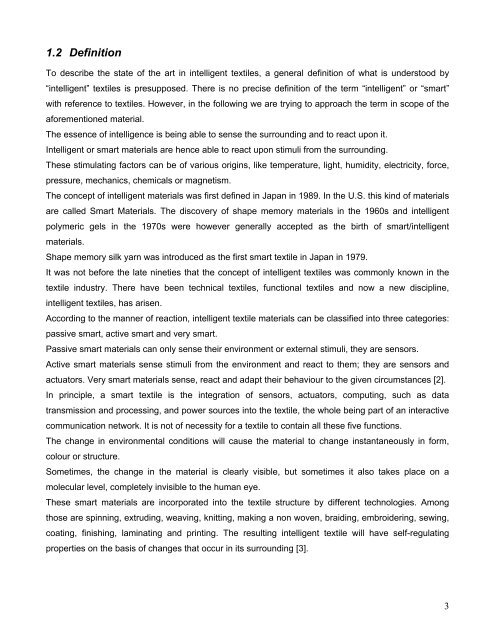Clevertex - Grado Zero Espace Srl
Clevertex - Grado Zero Espace Srl
Clevertex - Grado Zero Espace Srl
Create successful ePaper yourself
Turn your PDF publications into a flip-book with our unique Google optimized e-Paper software.
1.2 Definition<br />
To describe the state of the art in intelligent textiles, a general definition of what is understood by<br />
“intelligent” textiles is presupposed. There is no precise definition of the term “intelligent” or “smart”<br />
with reference to textiles. However, in the following we are trying to approach the term in scope of the<br />
aforementioned material.<br />
The essence of intelligence is being able to sense the surrounding and to react upon it.<br />
Intelligent or smart materials are hence able to react upon stimuli from the surrounding.<br />
These stimulating factors can be of various origins, like temperature, light, humidity, electricity, force,<br />
pressure, mechanics, chemicals or magnetism.<br />
The concept of intelligent materials was first defined in Japan in 1989. In the U.S. this kind of materials<br />
are called Smart Materials. The discovery of shape memory materials in the 1960s and intelligent<br />
polymeric gels in the 1970s were however generally accepted as the birth of smart/intelligent<br />
materials.<br />
Shape memory silk yarn was introduced as the first smart textile in Japan in 1979.<br />
It was not before the late nineties that the concept of intelligent textiles was commonly known in the<br />
textile industry. There have been technical textiles, functional textiles and now a new discipline,<br />
intelligent textiles, has arisen.<br />
According to the manner of reaction, intelligent textile materials can be classified into three categories:<br />
passive smart, active smart and very smart.<br />
Passive smart materials can only sense their environment or external stimuli, they are sensors.<br />
Active smart materials sense stimuli from the environment and react to them; they are sensors and<br />
actuators. Very smart materials sense, react and adapt their behaviour to the given circumstances [2].<br />
In principle, a smart textile is the integration of sensors, actuators, computing, such as data<br />
transmission and processing, and power sources into the textile, the whole being part of an interactive<br />
communication network. It is not of necessity for a textile to contain all these five functions.<br />
The change in environmental conditions will cause the material to change instantaneously in form,<br />
colour or structure.<br />
Sometimes, the change in the material is clearly visible, but sometimes it also takes place on a<br />
molecular level, completely invisible to the human eye.<br />
These smart materials are incorporated into the textile structure by different technologies. Among<br />
those are spinning, extruding, weaving, knitting, making a non woven, braiding, embroidering, sewing,<br />
coating, finishing, laminating and printing. The resulting intelligent textile will have self-regulating<br />
properties on the basis of changes that occur in its surrounding [3].<br />
3

















